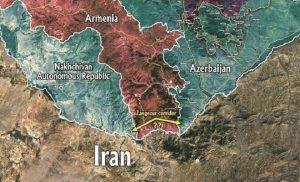The Zangezur Corridor, a proposed 43-kilometer transport route through Armenia’s Syunik Province, has emerged as a pivotal element in the geopolitical landscape of the South Caucasus. This corridor, intended to connect mainland Azerbaijan to its Nakhchivan exclave and extend to Turkey, has sparked intense debate due to its strategic and economic implications.
Historical Context of the Zangezur Corridor
Following the historic peace agreement between Armenia and Azerbaijan in March 2025, the Zangezur Corridor has been rebranded under the influence of former U.S. President Donald Trump, who proposed U.S. oversight of the route, a move that has stirred both regional and international reactions.
For Iran, the Zangezur Corridor represents a complex challenge, threatening its regional influence while offering potential economic opportunities.
This article explores the story of the Zangezur Corridor, its significance for Iran, the potential problems arising from its Trump-branded initiative, and the broader implications for regional stability and Iran’s geopolitical standing.
The concept of the Zangezur Corridor originates from the Soviet era when railway and highway connections linked Azerbaijan’s mainland to Nakhchivan through Armenia’s Syunik region.
These routes were severed during the First Nagorno-Karabakh War in the early 1990s, isolating Nakhchivan and forcing Azerbaijan to rely on air travel or routes through Iran for access.
The 2020 Nagorno-Karabakh ceasefire agreement, brokered by Russia, included provisions for unblocking regional transport links, with Article 9 specifically addressing a connection between Azerbaijan and Nakhchivan.
This clause laid the groundwork for the Zangezur Corridor, a term popularized by Azerbaijani President Ilham Aliyev in 2021, envisioning a route free of Armenian checkpoints and secured by Russian border guards.
For Iran, the Zangezur Corridor is more than a transit route; it is a geopolitical flashpoint. Historically, Iran has maintained strong ties with Armenia, partly to counterbalance the influence of Azerbaijan and Turkey, its regional rivals.
The corridor’s potential to shift trade dynamics and empower a Turkey-Azerbaijan axis threatens Iran’s strategic interests, particularly its land access to Armenia and its role in regional trade networks. you can read more about this topic here.
Strategic Importance of the Zangezur Corridor for Iran
The Zangezur Corridor holds significant implications for Iran’s geopolitical and economic strategies. Iran’s northern border with Armenia serves as a critical link for trade and connectivity with the South Caucasus and beyond.
The corridor, if implemented under foreign control, could disrupt this access, isolating Iran from Armenia and reducing its influence in the region.
Tehran fears that the Zangezur Corridor would strengthen pan-Turkic ambitions, potentially fueling separatist sentiments among Iran’s sizable Azerbaijani minority in its northwest provinces.
Economically, Iran has relied on its existing route through the Aras Corridor to facilitate trade between Azerbaijan and Nakhchivan.
The Zangezur Corridor, by offering a shorter and more efficient alternative, could diminish Iran’s role as a transit hub, impacting its economic leverage.
Iranian officials, including Foreign Minister Abbas Araghchi, have declared the corridor a “red line,” emphasizing that any alteration to regional borders or control over transit routes is unacceptable.
Furthermore, the corridor’s integration into global trade networks, such as China’s Belt and Road Initiative or the Middle Corridor, could sideline Iran, which has already felt excluded from major Eurasian trade routes.
However, the Zangezur Corridor also presents potential opportunities for Iran. If managed cooperatively, it could integrate Iran into broader regional trade networks, enhancing connectivity with Russia, Turkey, and Central Asia.
The challenge lies in ensuring that the corridor respects Armenia’s sovereignty and does not undermine Iran’s strategic interests.
The Peace Agreement and the Trump-Branded Zangezur Corridor
The peace agreement between Armenia and Azerbaijan in March 2025 marked a historic step toward resolving decades of conflict over Nagorno-Karabakh.
The agreement included provisions for reopening transport links, with the Zangezur Corridor as a central component.
However, the U.S. proposal, attributed to the influence of former President Donald Trump, to lease the corridor to an American company for 100 years has introduced new complexities.
This initiative, likened to U.S. administration of the Panama Canal, aims to stabilize the region by placing the corridor under neutral, U.S.-based commercial oversight, reducing Russian and Iranian influence.
The rebranding of the Zangezur Corridor under Trump’s name has symbolic and practical implications. Symbolically, it positions the U.S. as a key mediator in the South Caucasus, challenging Russia’s traditional role as the region’s security guarantor.
Practically, it raises concerns about sovereignty, particularly for Armenia, which insists on maintaining control over any transit route through its territory.
For Iran, the Trump-branded Zangezur Corridor represents a direct threat to its regional influence, as it could align the corridor with Western interests and further isolate Tehran.
Potential Problems Arising from the Trump-Branded Zangezur Corridor
The Trump-branded Zangezur Corridor introduces several potential problems, particularly for Iran:
- Loss of Regional Influence: The U.S.-managed corridor could diminish Iran’s geopolitical leverage by strengthening Azerbaijan and Turkey’s connectivity while sidelining Iran’s Aras Corridor. This shift could reduce Iran’s role in regional trade and weaken its strategic partnership with Armenia.
- Threat to Sovereignty and Regional Stability: Armenia’s opposition to an extraterritorial corridor, coupled with Azerbaijan’s insistence on unimpeded access without Armenian checkpoints, creates a risk of renewed tensions. Iran, wary of any changes to regional borders, may escalate diplomatic or military measures to counter the corridor, potentially destabilizing the fragile peace.
- Pan-Turkic Ambitions: Iran perceives the Zangezur Corridor as a tool for Turkey and Azerbaijan to advance pan-Turkic nationalism, which could inspire separatist movements among Iran’s Azerbaijani population. This concern is heightened by Turkey’s vision of the corridor as a “Turkic superhighway” connecting Istanbul to Central Asia.
- Economic Isolation: By diverting trade away from Iran’s routes, the Zangezur Corridor could exacerbate Iran’s economic isolation, particularly amid existing sanctions. The corridor’s integration into global trade networks, such as the Middle Corridor, could further marginalize Iran’s role in Eurasian logistics.
- Environmental and Social Risks: The Zangezur Mountains, where the corridor is proposed, are ecologically fragile and home to local communities. Construction could lead to environmental degradation and displacement, sparking protests in Armenia and potentially drawing Iran into regional disputes as a defender of Armenian interests.
- Great Power Rivalry: The U.S. proposal introduces a new layer of competition among global powers, including Russia, China, and the West. Russia, which initially sought to secure the corridor through its FSB border service, may view U.S. involvement as a challenge to its influence, potentially straining Iran-Russia relations. Similarly, China’s interest in the corridor as part of its Middle Corridor could complicate Iran’s alignment with Beijing.
Iran’s Response and Strategic Considerations
Iran’s strong opposition to the Zangezur Corridor reflects its broader strategy to maintain influence in the South Caucasus. Tehran has consistently rejected any arrangement that undermines Armenia’s sovereignty or alters regional borders.
In June 2025, Iran’s ambassador to Armenia, Mehdi Sobhani, reiterated Tehran’s opposition, emphasizing the importance of territorial integrity.
Iran has also proposed alternative routes, such as the Aras Corridor, to maintain its role as a transit hub and counter the Zangezur Corridor’s impact.
Diplomatically, Iran has sought to balance its relations with Armenia and Azerbaijan while countering Turkish and Western influence.
The peace agreement between Armenia and Azerbaijan has placed Iran in a delicate position, as improved relations between Yerevan and Baku could reduce Armenia’s reliance on Tehran.
To mitigate this, Iran has deepened economic and military cooperation with Armenia, including joint infrastructure projects and arms deals.
Iran’s concerns about the Trump-branded Zangezur Corridor also reflect its broader geopolitical anxieties. The U.S. proposal aligns with Western efforts to curb Russian and Iranian influence in the South Caucasus, potentially bringing NATO-aligned infrastructure closer to Iran’s borders.
Tehran’s response may involve strengthening ties with Russia and China to counterbalance Western involvement, though recent tensions with Moscow over the corridor suggest a possible shift toward a more independent foreign policy.
Opportunities for Iran in a Cooperative Framework
Despite its challenges, the Zangezur Corridor could offer Iran opportunities if managed cooperatively. A regionally inclusive approach, respecting Armenia’s sovereignty and involving Iran in the corridor’s operations, could enhance Iran’s connectivity with Russia, Turkey, and Central Asia.
The corridor’s integration into the International North-South Transport Corridor, as proposed by Aliyev, could provide Iran with new trade routes to Russia and Europe, boosting its economy.
For this to happen, Iran would need assurances that the corridor does not undermine its strategic interests. A negotiated framework, potentially involving international mediators like the UN or neutral parties, could ensure that the corridor benefits all stakeholders while preserving regional stability.
Armenia’s “Crossroads of Peace” initiative, which promotes reopening Soviet-era transport links under Armenian control, aligns with Iran’s interests and could serve as a model for cooperation.
Broader Implications for Regional Peace
The Zangezur Corridor’s success hinges on the delicate balance of interests among Armenia, Azerbaijan, Iran, Turkey, Russia, and the U.S.
The peace agreement between Armenia and Azerbaijan has created a window for reconciliation, but the corridor’s implementation remains a sticking point.
Azerbaijan’s insistence on unimpeded access and Armenia’s emphasis on sovereignty highlight the challenges of operationalizing the corridor without reigniting conflict.
For Iran, the corridor’s significance lies in its potential to reshape the South Caucasus’ geopolitical landscape. A U.S.-managed Zangezur Corridor could tilt the balance toward Western and Turkish interests, marginalizing Iran and Russia.
Conversely, a cooperative framework that includes Iran could strengthen regional integration, fostering economic growth and stability.
The corridor’s environmental and social impacts also require careful consideration to avoid exacerbating tensions in Armenia’s Syunik region.
The Zangezur Corridor stands at the crossroads of conflict and opportunity in the South Caucasus. For Iran, it represents a challenge to its regional influence, particularly with the U.S.-backed, Trump-branded initiative threatening to sideline Tehran’s strategic interests.
The corridor’s potential to empower Azerbaijan and Turkey, disrupt Iran’s trade routes, and fuel regional tensions underscores the need for a balanced approach that respects Armenia’s sovereignty and includes Iran as a stakeholder.
As the South Caucasus navigates this new geopolitical landscape, the Zangezur Corridor’s future will depend on diplomatic efforts to address the concerns of all parties.
Iran’s role in these discussions will be critical, as it seeks to maintain its influence while adapting to the region’s evolving dynamics.
Whether the corridor becomes a symbol of regional cooperation or a source of renewed conflict will shape the South Caucasus’ trajectory for decades to come.
source: raialkhalij



